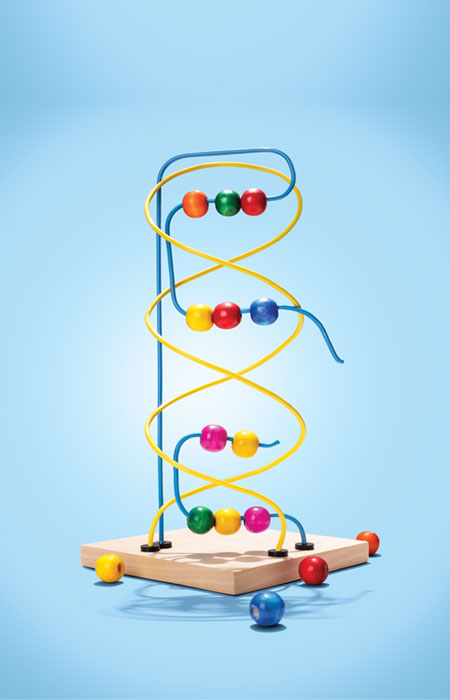Troubled
Helix
Miller School researchers are uncovering the
genetic variations that lead to disease and disability
By Louis Greenstein
Photo illustrations by John Kuczala
genetic variations that lead to disease and disability

Thanks to the Human Genome Project, which was completed in 2003, scientists have sequenced all 3.2 billion base pairs of DNA. Having cracked the genetic code, we’ve learned more in the past 30 years than ever before about genetic defects that cause conditions ranging from intellectual disabilities to hearing loss to infant death. Some are common, others rare. Some are deadly, others treatable. Some originate from a missing or inactive gene; others from a mysteriously disordered gene sequence. Many require more time to identify and — hopefully, one day — to treat, cure or even eliminate.
The John P. Hussman Institute for Human Genomics and the Dr. John T. Macdonald Foundation Department of Human Genetics, in collaboration with the Mailman Center for Child Development, all at the Miller School of Medicine, are hubs for the research and treatment of genetic conditions, including many that affect children.
Detectable Today
Galactosemia is a potentially deadly genetic condition that can be identified at birth. People born with it can’t break down galactose, a simple sugar found in milk. If an infant with galactosemia swallows milk — even mother’s milk — galactose begins to build up in the baby’s system, causing liver, brain, eye and kidney damage. Treatment is simple: Eliminate milk and formulas containing lactose.
Florida’s newborn screening program, administered by the state’s Department of Health, screens for 54 disorders including the most common form of galactosemia. Blood is drawn from every newborn (unless the parents object), and the hospital sends the samples to the Bureau of Public Health Laboratories in Jacksonville for screening. If there are abnormalities, patients are referred to one of four centers in Florida. One is the Division of Clinical and Translational Genetics at the Miller School. From screenings come treatment plans. Treatment for galactosemia is dietary, and the outcome immediate. Other diseases and conditions, such as sickle cell disease, require a more complex response.
“When sickle cell disease is diagnosed through newborn screening, the infant can begin prophylactic treatments,” said Daniel Armstrong, Ph.D., senior associate dean for child health at the Miller School and director of the Mailman Center. “They get vaccinations against pneumonia. They get brain scans and therapy to prevent stroke. These early interventions have led to major change in the lifespan of children with sickle cell disease.”

Also detectable is fragile X, an inherited intellectual disability disorder affecting one in every 4,000 boys. (Girls can be affected, but it’s less severe because females carry the additional X chromosome.) According to Deborah Barbouth, M.D., associate professor of human genetics, 60 to 80% of fragile X patients also have autism. They’re not missing a gene.
“The gene is there. It’s just silent,” she said. “We have to figure out how to turn it on. The technology we have with gene therapy is very promising. It’s a matter of time. I’m optimistic.” Male premutation carriers show no fragile X symptoms but have a higher incidence of autism and ADHD than male non-carriers, as well as fragile X-associated tremor/ataxia syndrome as they get older. Twenty percent of female carriers experience early menopause, while others experience depression, anxiety, or autoimmune diseases. The fragile X gene may regulate many other genes. If so, “we can help a lot of other causes of autism,” Dr. Barbouth said.
Treatable Tomorrow?

There is no treatment yet for fragile X syndrome, but there are promising gene therapies for other conditions. Spinal muscular atrophy (SMA) is a rare central nervous system disorder. In its most severe form, SMA causes babies to experience significant motor development delay and die at an early age, according to Mustafa Tekin, M.D., professor and chief of the Division of Clinical and Translational Genetics. In 2019, the Food and Drug Administration approved a gene therapy to treat SMA. The drug, Zolgensma, has been shown to slow the disease’s progression in up to 40% of patients.
“We see some recovery and survival,” Dr. Tekin said. “The quality of life is much better than dying in early infancy.”
While galactosemia comes from a single, identifiable gene mutation, autism is a complex condition that can’t be detected through a blood screen — only by observing behavior. According to Margaret Pericak-Vance, Ph.D., director of the Hussman Institute and executive vice chair of the Dr. John T. Macdonald Foundation Department of Human Genetics, autism is “one of the most genetic of the neurodevelopmental conditions” and may be triggered by multiple genes. While some researchers study isolated cases, Miller School investigators “went the route of larger families with multiple cases and looking at the common genes that are involved,” Dr. Pericak-Vance said.
“We need more discovery and understanding of how these genes contribute to the phenotype,” said Anthony Griswold, Ph.D., research assistant professor of human genetics in the Hussman Institute. The institute is working with other institutions to analyze data from 50,000 families with autism across a wide spectrum of phenotypes as part of the SPARK (Simons Foundation Powering Autism Research) initiative — a landmark autism research project. “More than 30 sites around the country are collecting data and doing the genetics,” Dr. Griswold said.
“There’s a long list of genes associated with autism,” said Derek Dykxhoorn, Ph.D., co-director of the Center for Molecular Genetics at the Hussman Institute and research associate professor in the Department of Human Genetics. “There has to be a convergent biological mechanism driving the clinical phenotype.”
Because of its complexity, one hope isn’t to “cure” autism, but to develop a treatment to reduce its most severe symptoms. In the long term, perhaps, a patient who would otherwise be nonverbal with no hope of independence could be higher functioning and independent. Another hope is to develop a genetic test to identify autism, which would help drive early intervention.
Another common inherited condition with no “cure” is Down syndrome. Willa Thorson, M.D., assistant professor of clinical genetics, is establishing a formal interdisciplinary Down syndrome clinic at the Mailman Center. Some Down syndrome clinics focus on medical issues, while others look at intellectual development using social workers, physical therapists and other caregivers.
“Hopefully we can do a little of both,” said Dr. Thorson. “Once I have a large cohort of patients and samples,” she said, “it will give a lot of opportunities for clinical and translational research.”
Dr. Tekin and R. Grace Zhai, Ph.D., associate professor of molecular and cellular pharmacology, and senior associate dean for basic science research, have NIH grants to study disorders that aren’t identified through clinical investigations. Their goal: detect underlying genetic variants for rare and undiagnosed diseases; understand the mechanism of genetic variations; and potentially identify medications, dietary changes, enzyme replacements and more.
“We are able to get together nationally with experts in rare disease and share these super-rare presentations of the patients,” Dr. Tekin said. “We look at all the DNA findings together and if we think that one variant is promising, we create animal models to test our predictions.”
Generating Interest in Genetics
“Because genetics underlies so much of what happens in health care,” said Dr. Dykxhoorn, “it has to be considered as part of our toolbelt for diagnosis and prognosis.”
The Miller School offers a two-year clinical genetics residency training program. It also is the nation’s only medical school to offer a four-year dual-degree program that awards an M.D. and an M.S. in genomic medicine. The training prepares students to enter the profession with a deep knowledge of genetics, no matter what specialty they choose for their practice.
“I am in my 35th year at UM,” said Dr. Armstrong, whose career has been dedicated to clinical care and research into genetic disorders and chronic illnesses of childhood. “Today, our child patients introduce me to their own spouses and kids. It’s great to see the children we took care of 35 years ago as grown-ups and learn from what they now experience as adults.”
“When sickle cell disease is
diagnosed through newborn screening, the infant can begin prophylactic treatments,” said Daniel Armstrong. “They get vaccinations against pneumonia. They get brain scans and therapy to prevent stroke. These early interventions have led to major change in the lifespan of children with sickle cell disease.”



